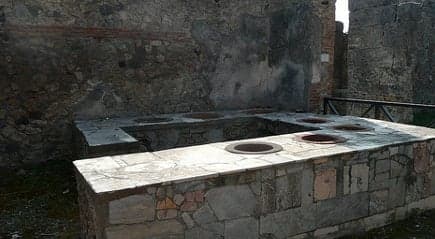Pompeii’s poor ate sea urchins and giraffe

Lower and middle class people of Pompeii, the Roman city destroyed by a volcano in 79AD, dined off exotic delicacies including sea urchins and giraffe and didn't just live off scraps as commonly believed, archaeologists from the University of Cincinnati revealed.
The team of archaeologists from the US university debunked the belief that the poor survived off grain and bowls of gruel after spending more than 10 years analysing houses, shops and businesses within a “non-elite” area of the city, where some buildings dated back to the sixth century, La Repubblica reported.
They mostly covered the so-called “fast-food joints”, which lined the city’s streets and were used by the poor while the wealthy ate at home.
An analysis of food and human waste from drains, latrines and cesspits behind the food sellers discovered a variety of cheap and widely-available food, including grains, fruit, nuts, eggs, olives and fish.
But a drain from a central property revealed a richer range of foods including sea urchins, shellfish and even the butchered leg joint of a giraffe. Traces of exotic spices from Indonesia were also found.
"The traditional vision of some mass of hapless lemmings - scrounging for whatever they can pinch from the side of a street, or huddled around a bowl of gruel - needs to be replaced by a higher fare and standard of living, at least for the urbanites in Pompeii," Steven Ellis, a classics professor at the University of Cincinnati and the study's co-author, said in a statement.
Ellis added that the giraffe bone "represents the height of exotic food" and is underscored by the fact that it is thought to be the only giraffe bone ever recorded from an excavation in Roman Italy.
"How part of the animal, butchered, came to be a kitchen scrap in a seemingly standard Pompeian restaurant not only speaks to long-distance trade in exotic and wild animals, but also something of the richness, variety and range of a non-elite diet," he said.
The giant eruption of Mount Vesuvius devastated Pompeii nearly 2,000 years ago in 79AD but the ash and rock helped preserve many buildings almost in their original state, as well as the curled-up corpses of victims.
Don't miss a story about Italy - Join us on Facebook and Twitter.
Comments
See Also
The team of archaeologists from the US university debunked the belief that the poor survived off grain and bowls of gruel after spending more than 10 years analysing houses, shops and businesses within a “non-elite” area of the city, where some buildings dated back to the sixth century, La Repubblica reported.
They mostly covered the so-called “fast-food joints”, which lined the city’s streets and were used by the poor while the wealthy ate at home.
An analysis of food and human waste from drains, latrines and cesspits behind the food sellers discovered a variety of cheap and widely-available food, including grains, fruit, nuts, eggs, olives and fish.
But a drain from a central property revealed a richer range of foods including sea urchins, shellfish and even the butchered leg joint of a giraffe. Traces of exotic spices from Indonesia were also found.
"The traditional vision of some mass of hapless lemmings - scrounging for whatever they can pinch from the side of a street, or huddled around a bowl of gruel - needs to be replaced by a higher fare and standard of living, at least for the urbanites in Pompeii," Steven Ellis, a classics professor at the University of Cincinnati and the study's co-author, said in a statement.
Ellis added that the giraffe bone "represents the height of exotic food" and is underscored by the fact that it is thought to be the only giraffe bone ever recorded from an excavation in Roman Italy.
"How part of the animal, butchered, came to be a kitchen scrap in a seemingly standard Pompeian restaurant not only speaks to long-distance trade in exotic and wild animals, but also something of the richness, variety and range of a non-elite diet," he said.
The giant eruption of Mount Vesuvius devastated Pompeii nearly 2,000 years ago in 79AD but the ash and rock helped preserve many buildings almost in their original state, as well as the curled-up corpses of victims.
Don't miss a story about Italy - Join us on Facebook and Twitter.
Join the conversation in our comments section below. Share your own views and experience and if you have a question or suggestion for our journalists then email us at [email protected].
Please keep comments civil, constructive and on topic – and make sure to read our terms of use before getting involved.
Please log in here to leave a comment.